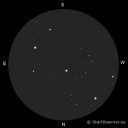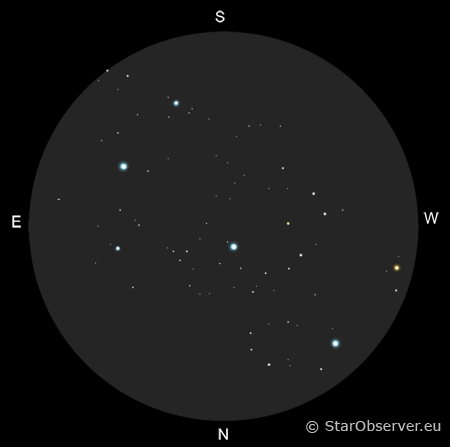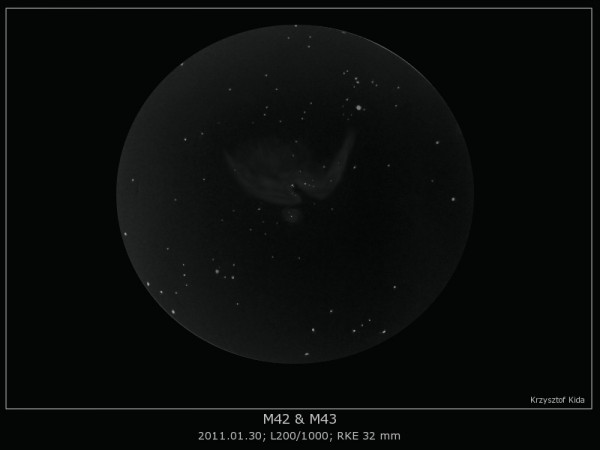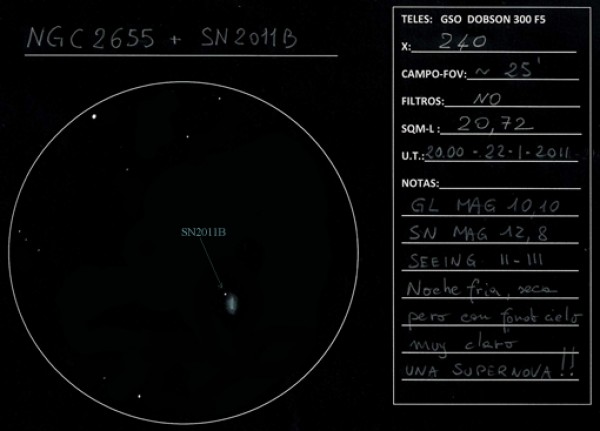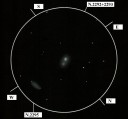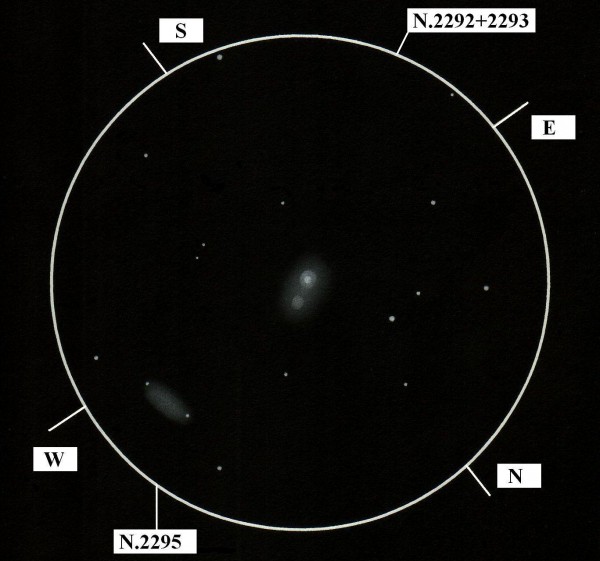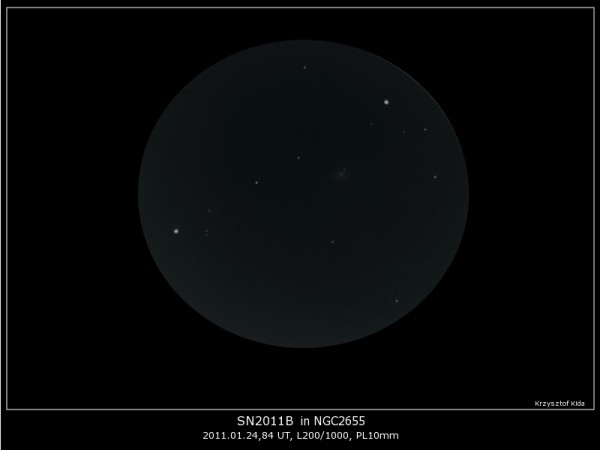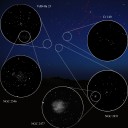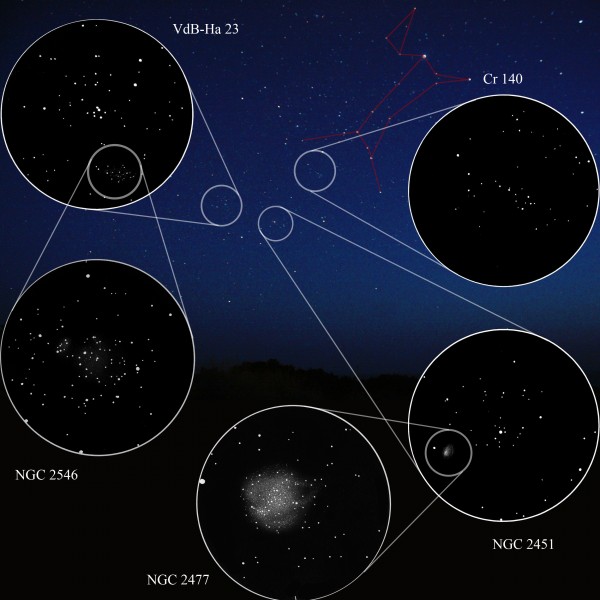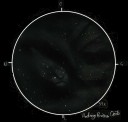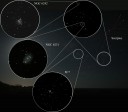Hello.
Here is my sketch of Jupiter’s 05-08-2010.szkicowałem pencil, light treatment in GIMP.szkic done from memory and my notes from that day during the observation of this planet, so all details are in place. 🙂 Seeing was good. achromatic Vixen telescope is 80/1200 with the eyepiece 9mm UO HD Ortho at 133x.
Category: Inverted
Belt of Orion
Hi,
Here’s a recent sketch I made from the Belt of Orion (Collinder 70) a few weeks ago, using my 15×80 Vixen Big Binocular, mounted on the SkyWindow (a mirror mount). The field of view is about 3.5 degrees. The sketch was made from my own backyard. To see more of my sketches and observing reports, please visit http://www.starobserver.eu
Clear skies
Math
Stellar Nursery
Farthest Star Visible
Every star visible with a scope are from our galaxy, supernovas are an exception!
The exploded star was clearly visible, maybe could seem just a star, but friends is a SUPERNOVA!!
NGC 2655 + SN2011B
Galaxy + Supernova
Torroja del Priorat – Spain
22-01-2011
Graphite pencil and blending stump, simply inverted with PS and rounded stars too.
Greetings
Stefano
Galaxies in Collision
Sixty Four Million Years Ago a Star Exploded
Canis Maior & Puppis from Crete
I want to post my 2nd montage about a photo and sketches from the Sky in Crete.
From 2 to 10 April, 2010 we three – all Hungarian amateur astronomers (János Gábor Kernya, Gábor Sánta and me, Gergő Kovács) – were at Crete to enjoy near-south deepsky wonders in Puppis, Vela, Centaurus and Scorpius because these constellations or southern parts of them are never seen from our home. Observed Omega Cen, Cen A, NGC 2451, NGC 2477, NGC 6231 and more in the very clear sky. Light pollution was minimal.
In the image is the Puppis and the Canis Maior (with red lines) constellations, and in the rings open star clusters. The clusters is the (in clockwise order) Collinder 140, NGC 2451, NGC 2477, NGC 2546 and VdB-Ha 23. The NGC 2451, Cr 140 and VdB-Ha 23 is my sketches, the NGC 2546 and 2477 is Gábor Sánta’s sketch.
Objects: Collinder 140, NGC 2451, NGC 2477, NGC 2546, VdB-Ha 23.
Constellation: Canis Maior – Puppis
Date: 09. 04. 2010.
Time: 0:00-3:00 UTC
Location: 27 m above sea level next to Kalo Nero, SE Crete, Greece, EU
Instrument: 60mm Akr., 100mm Akr., 130mm Newton.
Limiting magnitude: better than 5.5
Media: white paper, black pencil (0.5mm), graphite, invert, Photoshop.
Best regards,
Gergő Kovács
Báránd, Hungary
Heart of the Beehive
Southern Beauty
Object Name: Eta Carina Nebula (NGC3372)
Object Type: Nebulae
Location: Itajobi – SP – Brazil
Date: 30/12/2010 – 05h15min U.T.
Media: 0.5mm 2B graphite pencil on white paper, scanned and inverted.
Telescope: 180mm f/D=6 reflector, dob. mount.
Eyepieces: Antares Plössl 10mm; GSO Super Plössl 32mm (as seen in the picture).
Barlow: GSO three-element 2.5x
Turbulence: 3/5 (regular).
Seeing: 4/5 (good).
Fair wind, no clouds, high temperatures.
If you are allowed to point your telescope (or even a bino) toward south, you’ll be able to see this stunning deep sky object. I was waiting Saturn to rise, the sky was nice, cloudless. I had observed this object sometimes before, without knowing its name. That night I decided to sketch it, so I could search for its name later. Positioning each star was surely the hardest part. I’ve observed it from my backyard, not thoroughly dark, but enough to see incredible features, specially using the barlow lens. The Keyhole Nebula, inside Eta Carina Nebula, was amazing. That’s the way I like to sketch: knowing nothing about the object in advance, not to influence the register. I prefer researching about it after observing, it’s much more pleasant. I hope you enjoy it, I loved the image I’ve seen.
Clear sky to all,
Rodrigo Pasiani Costa.
Montage of the Open Clusters of Scorpius
Dear APOD,
I will post my montage about a photo and sketches from the Sky in Crete.
From 2 to 10 April, 2010 we three – all Hungarian amateur astronomers (János Gábor Kernya, Gábor Sánta and me, Gergő Kovács) – were at Crete to enjoy near-south deepsky wonders in Puppis, Vela, Centaurus and Scorpius because these constellations or southern parts of them are never seen from our home. Observed Omega Cen, Cen A, NGC 2451, NGC 2477, NGC 6231 and more in the very clear sky. Light pollution was minimal.
In the image is the Scorpius constellation (with red lines), and in the rings is open star clusters. The clusters is the (in clockwise order) “False Comet” – cluster complex (next to the Scorpius constellation), M7, NGC 6231 and NGC 6242. The “False Comet and M7 is my sketches, the NGC 6231 drew is János Gábor Kernya, and the NGC 6242 is Gábor Sánta’s sketch.
Objects: M7, NGC 6231, NGC 6242.
Constellation: Scorpius
Date: 08. 04. 2010.
Time: 1:00-3:35 UTC
Location: 27 m above sea level next to Kalo Nero, SE Crete, Greece, EU
Instrument: 60mm Akr., 100mm Akr., 130mm Newton.
Limiting magnitude: better than 5.5
Media: white paper, black pencil (0.5mm), graphite, invert, Photoshop.
Best regards,
Gergő Kovács
Báránd, Hungary


